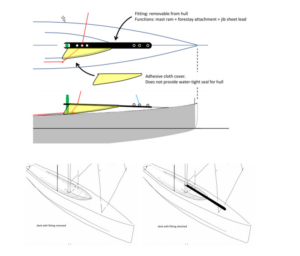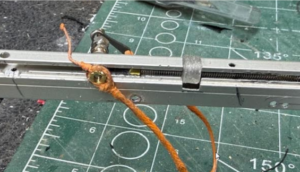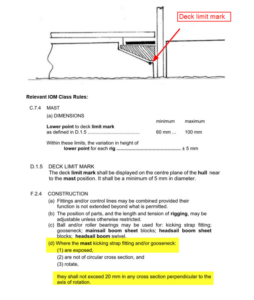Received from Japan NCA
Question:
Are movable deck fitting and adhesive cloth as shown on sketches below allowed in
accordance with the IOM Class Rules?

Relevant IOM Class Rules

Answer:
Item presented in the question is permitted. It is considered as hull fitting
contributing to the sti’ness and/or strength of the hull and therefore shall be of
materials permitted by class rule D.2.1.
Adhesive cloth cover is permitted.
Is an interpretation and consequent Class Rule change needed?
No.
Is controlling of the fixed length kicking strap tension using screw in the main boom, a
knurled nut and a slug that connects via a rod to the kicking strap strop that attaches
to both sides of the boom permitted?
Control of the fixed length kicking strap tension screw in the main boom
Received from Colin Hatton – designer and builder via GBR NCA
Question:
Is controlling of the fixed length kicking strap tension using screw in the main boom, a
knurled nut and a slug that connects via a rod to the kicking strap strop that attaches
to both sides of the boom permitted?

Vertical placement of deck limit mark.
Vertical placement of deck limit mark.
Received from designer Graham Bantock.
Relevant IOM Class Rules:
D.1.5 DECK LIMIT MARK
The deck limit mark shall be displayed on the centre plane of the hull near to
the mast position. It shall be a minimum of 5 mm in diameter.
F.2.4 CONSTRUCTION
(a) Fittings and/or control lines may be combined provided their function is not
extended beyond what is permitted.
(b) The position of parts, and the length and tension of rigging, may be adjustable
unless otherwise restricted.
(c) Ball and/or roller bearings may be used for: kicking strap fitting; gooseneck;
mainsail boom sheet blocks; headsail boom sheet blocks; headsail boom swivel.
(d) Where the mast kicking strap fitting and/or gooseneck:
(1) are exposed,
(2) are not of circular cross section, and
(3) rotate,
they shall not exceed 20 mm in any cross section perpendicular to the axis of
rotation.
Questions and Answers
Questions are related to the diagrams and explanations shown below.
Item 4
Question: Is it reasonable that the mast deck limit mark can be placed at some
distance down the mast trunking? Is this arrangement permitted?
Answer: Yes. Deck limit mark of minimum 5 mm in diameter shall be positioned on
the centre plan of the hull near the mast position as defined in the IOM Class Rule
D.1.5. Deck limit mark should be visible and should be possible to take measurement
from that point (centre of deck limit mark).
Item 5
Question: Whereas there have been aft extensions of the foredeck past the mast
position (and these are acknowledged as permitted by the Q&A), does the same logic
apply to a plate that more fully closes the well?
Is it correct to accept that the mast deck limit mark is placed underneath the plate
that more fully closes the well?
Answer: Deck limit mark may be placed on the deck underneath the kicking
strap/gooseneck mast fitting regardless of the type/execution of the kicking
strap/gooseneck mast fitting.
Item 6
Question: Whereas there have been aft extensions of the foredeck past the mast
position (and these are acknowledged as permitted by the Q&A), does the same logic
apply to a plate that more fully closes the well?
The mast kicking strap fitting in this case is normal. CR F2.4 (d) is complied with.
Is it permitted to place the mast deck limit mark underneath the plate that more fully
closes the well?
Answer: Yes
Diagrams of centre plane cross sections in region of mast – brief descriptions
In all diagrams the mast deck limit mark is located where indicated by the dot.
In all cases the kicking strap itself is a conventional thin wire or line.
1 The typical arrangement in the early days of the class. A flat deck, mast
trunking, mast deck limit mark on the flat deck adjacent to the mast.
2 The arrangement developed by Craig Smith around the mid1990s where the
foredeck is raised and a ‘cockpit’ is formed aft of the partial bulkhead just ahead of
the mast. The mast deck limit mark is on the floor of the cockpit adjacent to the mast.
3 The arrangement that evolved in the late 1990s where the foredeck is raised and
a ‘well’ is formed around the mast. The mast deck limit mark is on the floor of the well
adjacent to the mast.
4 As arrangement 3 but where the size of the well is progressively reduced to a
minimal size. The mast deck limit mark is on the floor of the well adjacent to the
mast.
5 As arrangement 3 but where the well is partially closed in by a plate (shown in
solid) attached to and flush with the surrounding deck. The kicking strap attachment
on the mast is a triangular plate in excess of 20 mm in vertical and horizontal
dimensions (shown hatched). The kicking strap is near vertical connecting the main
boom to the mast kicking strap attachment. The mast deck limit mark is on the floor
of the well adjacent to the mast.
6 As arrangement 3 but where the well is partially closed in by a plate (shown in
solid) attached to and flush with the surrounding deck. The kicking strap is normal.
The mast deck limit mark is on the floor of the well adjacent to the mast.

29 January 2025
Is the mast kicking strap fitting and/or gooseneck on following sketch “exposed”
according to the IOM Class Rule F2.4 (d) (1)
Exposed mast kicking strap fitting and/or gooseneck.
Received from designer Graham Bantock.
Question:
Is the mast kicking strap fitting and/or gooseneck on following sketch “exposed” according
to the IOM Class Rule F2.4 (d) (1)

Answer
Deck limit mark is positioned on the deck as shown on the sketch. It is below
the mast kicking strap fitting and according to the IOM Class Rule F.2.4(d)(1) it is taken as
“exposed” so the fitting shall not exceed 20 mm in any cross section perpendicular to the
axis of rotation.
29 January 2025
